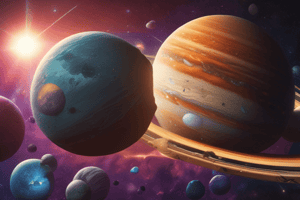Podcast
Questions and Answers
Which planets are considered the outer planets in the solar system?
Which planets are considered the outer planets in the solar system?
- Jupiter, Saturn, Uranus, and Neptune (correct)
- Mercury, Venus, Earth, and Mars
- Saturn, Uranus, Earth, and Venus
- Jupiter, Saturn, Mars, and Neptune
What term is used to describe the outer planets collectively?
What term is used to describe the outer planets collectively?
- Gas giants
- Terrestrial planets
- Dwarf planets
- Jovian planets (correct)
Which planet was formerly classified as a planet but is now categorized as a dwarf planet?
Which planet was formerly classified as a planet but is now categorized as a dwarf planet?
- Saturn
- Neptune
- Uranus
- Pluto (correct)
What distinguishes the outer planets from the inner planets?
What distinguishes the outer planets from the inner planets?
Which dwarf planet is thought to be made of various types of silicon?
Which dwarf planet is thought to be made of various types of silicon?
Which dwarf planet is located in the asteroid belt?
Which dwarf planet is located in the asteroid belt?
Which dwarf planet has the fastest rotation in the known solar system?
Which dwarf planet has the fastest rotation in the known solar system?
Which dwarf planet was considered a planet until 2006?
Which dwarf planet was considered a planet until 2006?
What is the average distance from the Sun for Makemake?
What is the average distance from the Sun for Makemake?
How many provisional moons are awaiting confirmation for Eris?
How many provisional moons are awaiting confirmation for Eris?
What is the radius of Eris?
What is the radius of Eris?
What causes Haumea to distort its shape into a flatter object?
What causes Haumea to distort its shape into a flatter object?
What is the primary difference between asteroids and comets?
What is the primary difference between asteroids and comets?
What distinguishes meteors from meteoroids and meteorites?
What distinguishes meteors from meteoroids and meteorites?
Where do most comets originate from?
Where do most comets originate from?
What is the defining characteristic of a meteoroid?
What is the defining characteristic of a meteoroid?
Which gas giant planet in the solar system has a massive storm called the Great Red Spot, which is twice the size of Earth?
Which gas giant planet in the solar system has a massive storm called the Great Red Spot, which is twice the size of Earth?
Which gas giant planet rotates horizontally on its side?
Which gas giant planet rotates horizontally on its side?
Which gas giant planet in the solar system is located about 2.8 million miles from the Sun?
Which gas giant planet in the solar system is located about 2.8 million miles from the Sun?
Which gas giant planet has 13 rings and 27 known moons?
Which gas giant planet has 13 rings and 27 known moons?
Which planet in the solar system has an atmosphere primarily composed of hydrogen, helium, and methane?
Which planet in the solar system has an atmosphere primarily composed of hydrogen, helium, and methane?
Which planet has a massive storm called the Great Red Spot, which is twice the size of Earth?
Which planet has a massive storm called the Great Red Spot, which is twice the size of Earth?
Which planet rotates horizontally on its side?
Which planet rotates horizontally on its side?
Which planet is the outermost planet in the solar system and has an atmosphere of hydrogen, helium, and methane?
Which planet is the outermost planet in the solar system and has an atmosphere of hydrogen, helium, and methane?
Flashcards are hidden until you start studying
Study Notes
Outer Planets in the Solar System: Key Characteristics and Comparisons
- Jupiter is the largest planet in the solar system, with a radius of 43,441 miles and a distance of about 484 million miles from the Sun.
- It has a hydrogen and helium gas atmosphere, over 75 moons, and a massive storm called the Great Red Spot, which is twice the size of Earth.
- Saturn, the second-largest planet, has a radius of 36,184 miles and is about 886 million miles from the Sun. It has hydrogen and helium gas atmosphere, seven rings, and 83 confirmed and unconfirmed moons.
- Uranus, the seventh farthest planet, is 1.8 billion miles from the Sun, has a radius of 15,759 miles, an atmosphere of hydrogen, helium, and methane, 13 rings, and 27 known moons. It rotates horizontally on its side.
- Neptune, the outermost planet, is 2.8 million miles from the Sun, with a radius of 15,299 miles, an atmosphere of hydrogen, helium, and methane, 14 moons, and 5 main rings.
- Gas giants, including Jupiter, Saturn, Uranus, and Neptune, lack a hard surface and are composed primarily of hydrogen and helium.
- The outer planets have a large number of satellites orbiting them: Jupiter with 75 moons, Saturn with 83, Uranus with 27, and Neptune with 14.
- All four outer planets have rings, with Saturn having the largest and most visible ring system.
- During the solar system's formation, gas and icy particles formed the outer planets, while inner planets are made of solid materials and are located closer to the Sun.
- Jupiter and Neptune share the characteristic of storms on their surfaces, with Jupiter's Great Red Spot and Neptune's Great Dark Spot being notable examples.
- The inner planets are smaller, made of solid materials, and are located closer to the Sun, while the outer planets are gas giants, with a boundary between Mars and Jupiter known as the asteroid belt.
- Dwarf planets, such as Pluto, Ceres, Eris, Makemake, and Haumea, were classified by the International Astronomical Union in 2006 and have distinct compositions and characteristics compared to regular planets.
Studying That Suits You
Use AI to generate personalized quizzes and flashcards to suit your learning preferences.




